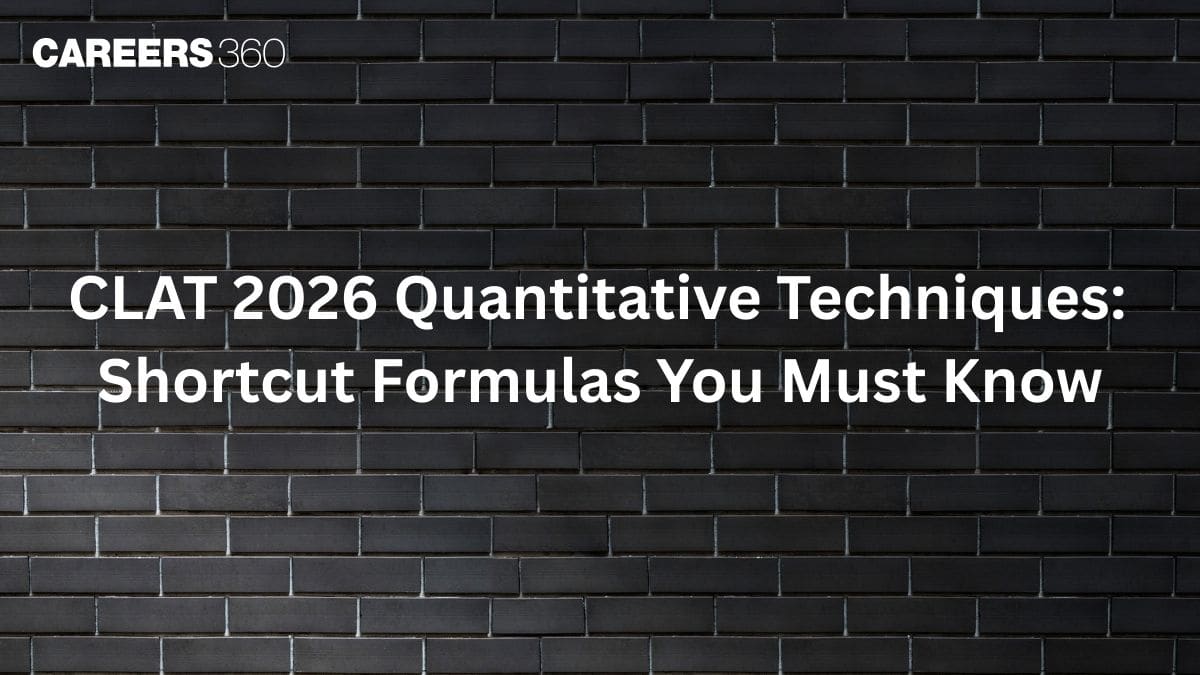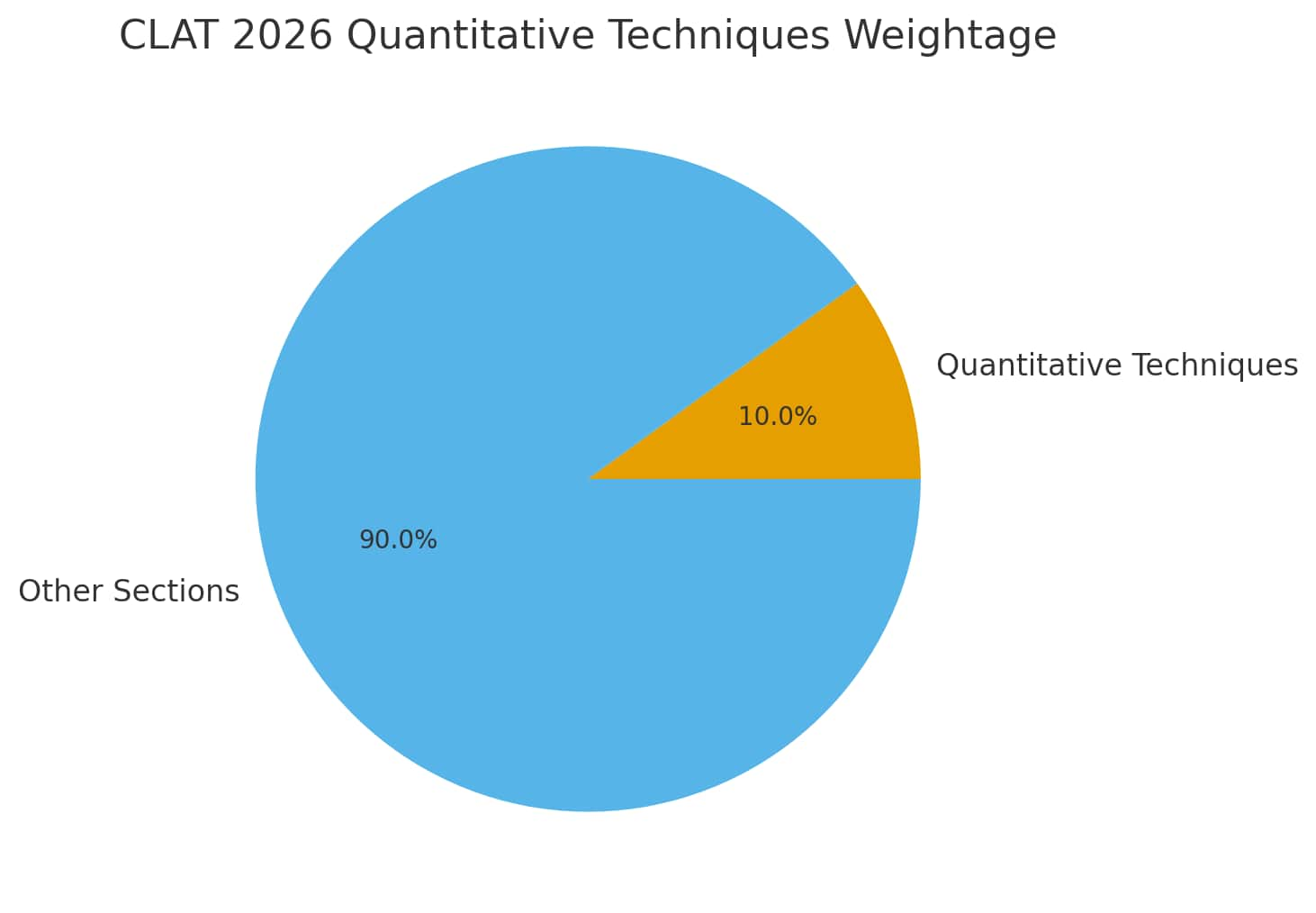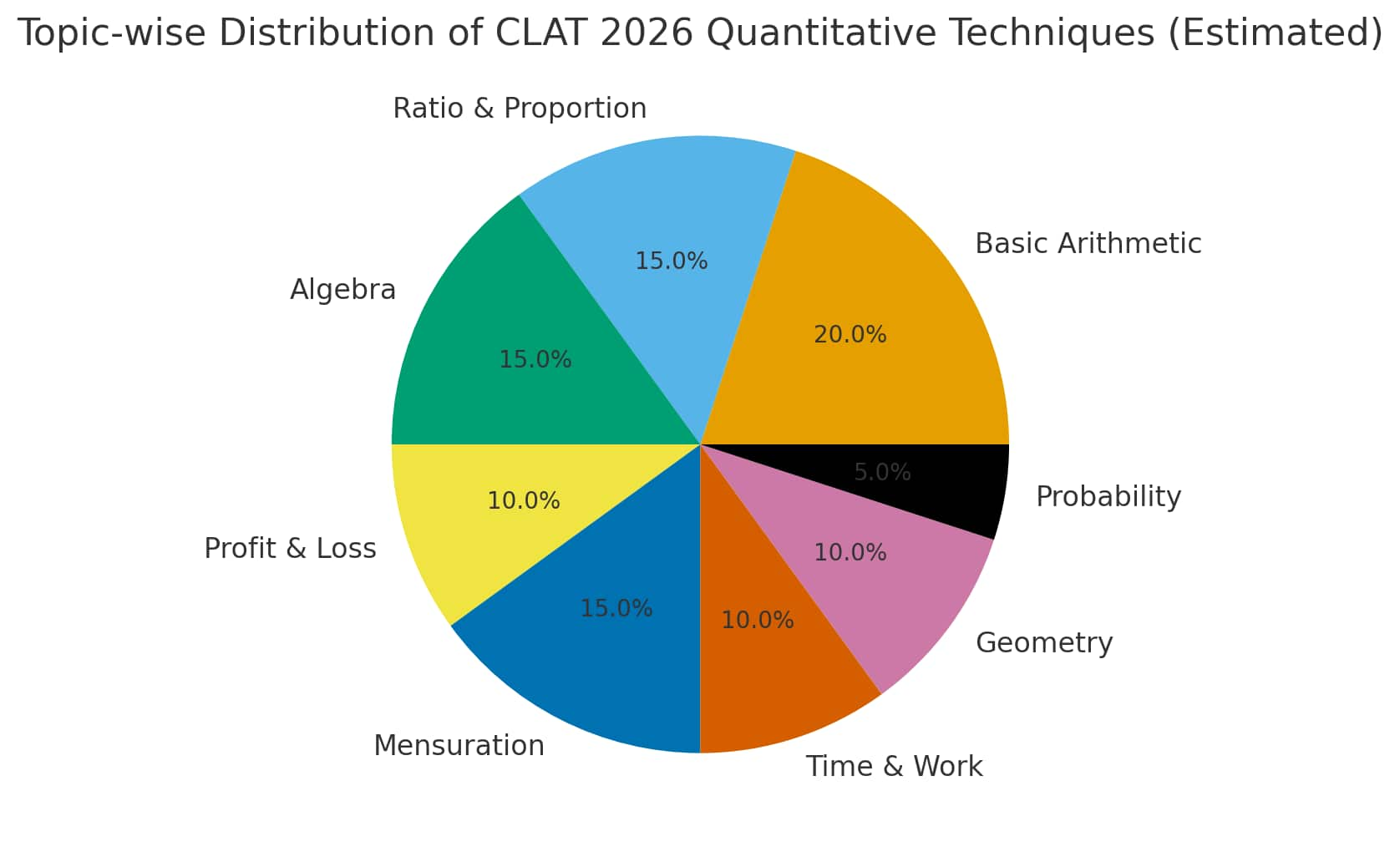Amity University-Noida Law Admissions 2026
Among top 100 Universities Globally in the Times Higher Education (THE) Interdisciplinary Science Rankings 2026
Numbers in the CLAT 2026 exam don’t have to be scary—they can actually become your scoring weapon if you know the right shortcuts. The Quantitative Techniques section of CLAT 2026 is designed to test your logical application of mathematics rather than lengthy calculations. This is where mastering shortcut formulas can save you precious minutes and boost your accuracy. From percentages and ratios to time-speed-distance and profit-loss, knowing the smart way to solve these problems is the real game-changer.
This Story also Contains

We'll provide the most important shortcut formulas that all CLAT Exam candidates need to be aware of in this post. These time-saving tips, which range from percentages and ratios to time-speed-distance and likelihood, will help you maximise your score under exam pressure while also boosting your confidence. Are you prepared to beat the clock? Let's explore the ultimate set of formulas that can make Quant your most powerful ally in CLAT 2026.

Particulars | Details |
Weight | 10% |
Type of questions | MCQs |
Number of questions | 10-14 |
Skills tested | Working with numerical data and performing class 10 mathematical operations. |
Important Topics | Basic Arithmetic Calculation, ratio and proportions, algebra, profit and loss, mensuration, time and work, geometry, probability. |
Topics | Shortcut Formulas |
Percentages and Ratios | Percentage change = Original Value/Difference×100 Relation between percentage and fraction:
Ratio to percentage = a/b×100% Shortcut Tip: Remember common fractions-to-percentages to avoid decimal calculations in DI sets. |
Averages | Average = Sum of Observations/ Number of Observations Combined Average: Shortcut Tip: For quick adjustments, use the “Deviation Method” (add or subtract deviations from the assumed average). |
Simple Interest and Compound Interest | Simple Interest (SI) = P×R×T/100 Compound Interest (CI) = P(1+100R) TP Shortcut Tip: For 2 years, CI= SI + 100 SIR |
Speed, Time and Distance | Speed = Distance / Time Average Speed (two equal distances): avgspeed = x + y2xy where x = speed in one direction, y = speed in return. Shortcut Tip: Convert km/hr to m/s by multiplying with 5/18. |
Work and Time | if A can complete work in X days and B in Y days: workdonein 1day = X1 + Y1 Work = Rate × Time Shortcut Tip: Use LCM of days to assign work units quickly. |
Profit, Loss and Discount | Profit% = Profit/CP×100 Loss% = Loss/CP×100 Discount% = Marked Price – Selling Price/Marked Price×100 Shortcut Tip: Always calculate percentages using Cost Price (CP), not Selling Price. |
Menstruation and Geometry | Area of circle = πr2 Circumference of circle = 2πr Area of triangle = 1/2×b×h Pythagoras' theorem: a2+b2=c2 Shortcut Tip: Memorise squares (1–30) and cubes (1–20) for faster calculation. |
Probability and Permutation Combination | Probability = Favourable Outcomes / Total Outcomes Permutation: nPr = n! / (n-r)! Combination: nCr=n! / r!(n−r)!n Shortcut Tip: CLAT usually asks simple cases like card-drawing or dice-rolling, so focus on direct application. |
Also Check: 100+ CLAT Quantitative Techniques Questions with Answers and Detailed Solutions by Careers360
Understanding the Shortcut formulas for the CLAT 2026 Quantitative Section is crucial. Below are the shortcut formulas for the CLAT 2026 Quantitative Techniques Section.
In the CLAT 2026 Quantitative Techniques portion, shortcut formulas are essential for time savings throughout the test. Relying on time-consuming traditional methods can waste valuable minutes because the part requires a lot of calculations. Students can try more questions in the allotted time by using shortcuts, which enable them to arrive at solutions far more quickly.
Additionally, these formulas aid in lowering the inaccuracies that frequently result from time-consuming computations. Candidates can ensure accuracy while working under pressure by minimising manual procedures and avoiding misunderstandings by using pre-learned strategies and direct results
For often asked questions like percentages, ratios, averages, profit and loss, and time-speed-distance, shortcut formulas are very helpful. Gaining proficiency in them guarantees that candidates can quickly remember techniques and use them in recurring patterns.
Increasing confidence is also important. Students who can use shortcuts to solve questions quickly during an exam gain momentum, reduce anxiety, and have more time to tackle more difficult or time-consuming tasks.
Lastly, quick formulas serve as a tool for modification. Students can concentrate on short formulas that cover a variety of question kinds rather than learning lengthy conceptual chunks. This increases the effectiveness and efficiency of last-minute preparation.
Among top 100 Universities Globally in the Times Higher Education (THE) Interdisciplinary Science Rankings 2026
Ranked #18 amongst Institutions in India by NIRF | Ranked #1 in India for Academic Reputation by QS Rankings | 16 LPA Highest CTC
Also Check: CLAT Mock Test with Solutions - 10 Free Mock Tests by Careers360

Use these techniques to get ready for the CLAT 2026 Exam Quantitative Techniques Section:
Learn the Syllabus: Start by learning the CLAT 2026 Syllabus and CLAT Exam Pattern in its entirety, paying particular attention to subjects like math, algebra, measurement, time and labour, profit and loss, simple and compound interest, and data interpretation. Sort the practice questions from the topics that have more weight in order of importance.
Conceptual Clarity: A solid understanding of fundamental ideas is crucial. Prior to taking on increasingly challenging issues, concentrate on understanding the basic concepts and formulas. You'll be able to answer questions more quickly and precisely as a result.
Frequent Practice: The secret to success is consistent practice. Every day, set aside a specific time to practice tasks. Begin with the CLAT Previous Year Question Paper and simpler issues and work your way up to more challenging ones. Get acquainted with the format and time limits of the exam by using past years' question papers and practice exams.
Accuracy and Speed: Make an effort to increase both. Practice problem-solving in timed situations to accomplish this. To complete questions more rapidly without sacrificing accuracy, use shortcuts and strategies. For example, learn how to simplify difficult fractions or spot patterns in number series.
Examine Your Errors: After every practice session, take some time to examine your errors. Recognising your mistakes enables you to prevent them from happening again. Make frequent revisions to ideas that you find challenging.
Mock examinations: To replicate exam settings, take a comprehensive CLAT Mock Test regularly. This enhances time management and builds endurance. After every practice exam, review the results to see what needs to be improved.
Time management: Plan how you will approach the exam's quantitative portion. Avoid spending too much time on a single question. If time allows, omit challenging questions and return to them later.
Go over the important formulas: Have a formula sheet on hand for easy access. To help you remember these formulas, review them frequently. This is especially useful when you're nearing the end of your preparation.
On Question asked by student community
With an AIR of 34724 and OBC category rank of 7153, chances of getting a seat in DSNLU Visakhapatnam are low in early rounds. However, since you are already invited for counselling, there may be some chance in later rounds depending on seat vacancy and cut-off movement. You should participate
With a CLAT LLM rank of 13656, getting a top NLU is difficult. You may have chances in lower-ranked NLUs or private law universities, depending on seat availability and category.
You can check CLAT LLM counselling details here:
https://law.careers360.com/articles/clat-llm-cut-off
With a CLAT PG rank of 1257 in the SC category and being a woman candidate with Rajasthan domicile, you do have a realistic chance of securing admission to several National Law Universities, though the top NLUs may be difficult at this rank. Admission chances depend heavily on category-wise cut-offs,
With a CLAT PG rank of around 11,000, getting admission into the top National Law Universities (NLUs) is not likely, as their general category cut-offs usually close much earlier. However, you still have realistic chances in lower-ranked and newer NLUs, especially in the later rounds of CLAT counselling or through
With a CLAT 2026 All India Rank around 2070, Telangana domicile, and holding an OBC certificate (girl candidate), your chances of getting admission into a top-tier NLU like NLSIU Bengaluru, NALSAR Hyderabad, NUJS Kolkata or NLU Jodhpur are quite low, as their closing ranks are usually much higher. However, you
Among top 100 Universities Globally in the Times Higher Education (THE) Interdisciplinary Science Rankings 2026
Ranked #18 amongst Institutions in India by NIRF | Ranked #1 in India for Academic Reputation by QS Rankings | 16 LPA Highest CTC
AICTE & UGC Approved | NAAC A+ Accredited
NAAC A++ Approved | Curriculum Aligned with BCI & UGC
India's Largest University | BCI approved | Meritorious Scholarships up to 5 lacs |
Integrated Learning – A balanced blend of management and legal education